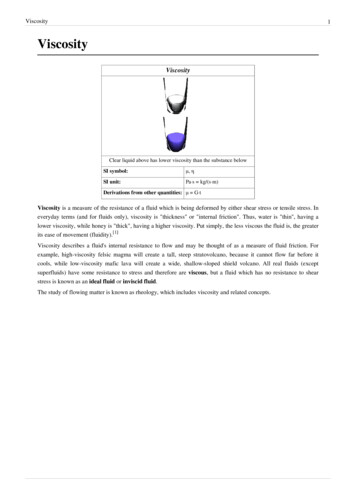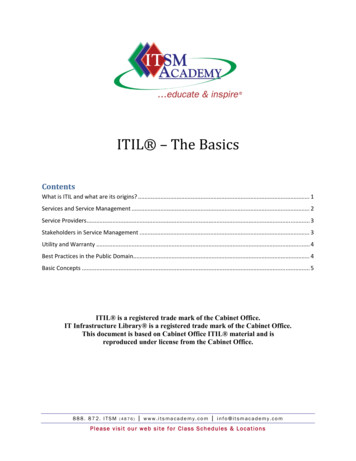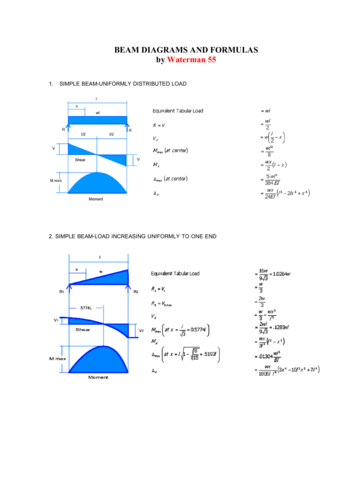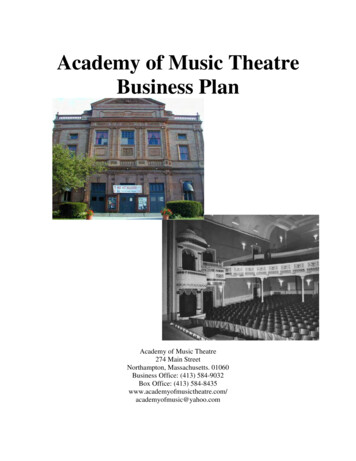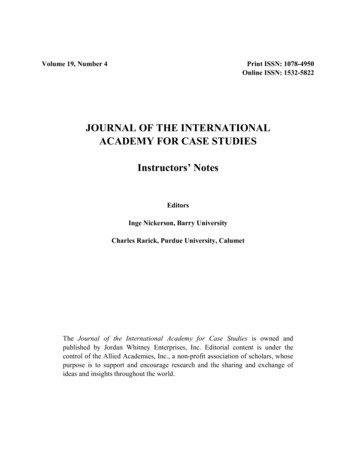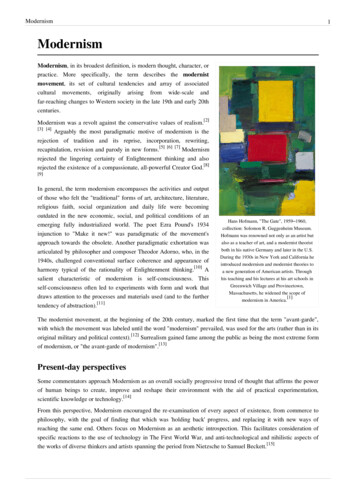
Transcription
Modernism1ModernismModernism, in its broadest definition, is modern thought, character, orpractice. More specifically, the term describes the modernistmovement, its set of cultural tendencies and array of associatedcultural movements, originally arising from wide-scale andfar-reaching changes to Western society in the late 19th and early 20thcenturies.Modernism was a revolt against the conservative values of realism.[2][3] [4]Arguably the most paradigmatic motive of modernism is therejection of tradition and its reprise, incorporation, rewriting,recapitulation, revision and parody in new forms.[5] [6] [7] Modernismrejected the lingering certainty of Enlightenment thinking and alsorejected the existence of a compassionate, all-powerful Creator God.[8][9]In general, the term modernism encompasses the activities and outputof those who felt the "traditional" forms of art, architecture, literature,religious faith, social organization and daily life were becomingoutdated in the new economic, social, and political conditions of anemerging fully industrialized world. The poet Ezra Pound's 1934injunction to "Make it new!" was paradigmatic of the movement'sapproach towards the obsolete. Another paradigmatic exhortation wasarticulated by philosopher and composer Theodor Adorno, who, in the1940s, challenged conventional surface coherence and appearance ofharmony typical of the rationality of Enlightenment thinking.[10] Asalient characteristic of modernism is self-consciousness. Thisself-consciousness often led to experiments with form and work thatdraws attention to the processes and materials used (and to the furthertendency of abstraction).[11]Hans Hofmann, "The Gate", 1959–1960,collection: Solomon R. Guggenheim Museum.Hofmann was renowned not only as an artist butalso as a teacher of art, and a modernist theoristboth in his native Germany and later in the U.S.During the 1930s in New York and California heintroduced modernism and modernist theories toa new generation of American artists. Throughhis teaching and his lectures at his art schools inGreenwich Village and Provincetown,Massachusetts, he widened the scope of[1]modernism in America.The modernist movement, at the beginning of the 20th century, marked the first time that the term "avant-garde",with which the movement was labeled until the word "modernism" prevailed, was used for the arts (rather than in itsoriginal military and political context).[12] Surrealism gained fame among the public as being the most extreme formof modernism, or "the avant-garde of modernism".[13]Present-day perspectivesSome commentators approach Modernism as an overall socially progressive trend of thought that affirms the powerof human beings to create, improve and reshape their environment with the aid of practical experimentation,scientific knowledge or technology.[14]From this perspective, Modernism encouraged the re-examination of every aspect of existence, from commerce tophilosophy, with the goal of finding that which was 'holding back' progress, and replacing it with new ways ofreaching the same end. Others focus on Modernism as an aesthetic introspection. This facilitates consideration ofspecific reactions to the use of technology in The First World War, and anti-technological and nihilistic aspects ofthe works of diverse thinkers and artists spanning the period from Nietzsche to Samuel Beckett.[15]
Modernism2HistoryBeginningsThe first half of the 19th century for Europe was marked by anumber of wars and revolutions, which contributed to an aesthetic"turning away" from the realities of political and socialfragmentation, and so facilitated a trend towards Romanticism.Romanticism had been a revolt against the values of the IndustrialRevolution and bourgeois conservative values,[2] [4] [3] puttingemphasis on individual subjective experience, the sublime, thesupremacy of "Nature" as a subject for art, revolutionary or radicalextensions of expression, and individual liberty.Eugène Delacroix's Liberty Leading the People, 1830,a Romantic work of artA Realist portrait of Otto von BismarckBy mid-century, however, a synthesis of the ideas of Romanticismwith stable governing forms had emerged, partly in reaction to thefailed Romantic and democratic Revolutions of 1848. It wasexemplified by Otto von Bismarck's Realpolitik and by "practical"philosophical ideas such as positivism. This stabilizing synthesis, theRealist political and aesthetic ideology, was called by variousnames—in Great Britain it is designated the "Victorian era" — and wasrooted in the idea that reality dominates over subjective impressions.Central to this synthesis were common assumptions and institutionalframes of reference, including the religious norms found inChristianity, scientific norms found in classical physics and doctrinesthat asserted that the depiction of external reality from an objectivestandpoint was not only possible but desirable. Cultural critics andhistorians label this set of doctrines realism, though this term is notuniversal. In philosophy, the rationalist, materialist and positivistmovements established a primacy of reason and system.Against the current ran a series of ideas, some of them direct continuations of Romantic schools of thought. Notablewere the agrarian and revivalist movements in plastic arts and poetry (e.g. the Pre-Raphaelite Brotherhood and thephilosopher John Ruskin). Rationalism also drew responses from the anti-rationalists in philosophy. In particular,Hegel's dialectic view of civilization and history drew responses from Friedrich Nietzsche and Søren Kierkegaard,who were major influences on existentialism. All of these separate reactions together began to be seen as offering achallenge to any comfortable ideas of certainty derived by civilization, history, or pure reason.From the 1870s onward, the ideas that history and civilization were inherently progressive and that progress wasalways good came under increasing attack. Writers Wagner and Ibsen had been reviled for their own critiques ofcontemporary civilization and for their warnings that accelerating "progress" would lead to the creation ofindividuals detached from social values and isolated from their fellow men. Arguments arose that the values of theartist and those of society were not merely different, but that Society was antithetical to Progress, and could notmove forward in its present form. Philosophers called into question the previous optimism. The work ofSchopenhauer was labelled "pessimistic" for its idea of the "negation of the will", an idea that would be both rejected
Modernism3and incorporated by later thinkers such as Nietzsche.Two of the most significant thinkers of the period were, in biology,Charles Darwin, and in political science, Karl Marx. Darwin's theory ofevolution by natural selection undermined the religious certainty of thegeneral public, and the sense of human uniqueness of the intelligentsia.The notion that human beings were driven by the same impulses as"lower animals" proved to be difficult to reconcile with the idea of anennobling spirituality. Karl Marx argued there were fundamentalcontradictions within the capitalist system—and that the workers wereanything but free. Both thinkers would spawn defenders and schools ofthought that would become decisive in establishing modernism. This isnot to say that all modernists or modernist movements rejected eitherreligion or all aspects of Enlightenment thought, rather that modernismcan be viewed as a questioning of the axioms of the previous age.Historians have suggested various dates as starting points formodernism. William Everdell has argued that modernism began withRichard Dedekind's division of the real number line in 1872 andBoltzmann's statistical thermodynamics in 1874. Clement Greenbergcalled Immanuel Kant "the first real Modernist",[16] but also wrote, "What can be safely called Modernism emergedin the middle of the last century—and rather locally, in France, with Baudelaire in literature and Manet in painting,and perhaps with Flaubert, too, in prose fiction. (It was a while later, and not so locally, that Modernism appeared inmusic and architecture)."[17] The modernist movement, at the beginning of the 20th century, marked marked the firsttime that the term "avant-garde", with which the movement was called until the word "modernism" prevailed, wasbeing used for the arts instead that in its original military and political context;[12] the term remained to describemovements which identify themselves as attempting to overthrow some aspect of tradition or the status quo.Surrealism gained the fame among the public of being the most extreme form of modernism, or "the avant-garde ofmodernism".[13]Odilon Redon, Guardian Spirit of the Waters,1878, charcoal on paper, The Art Institute ofChicagoSeparately, in the arts and letters, two ideas originating in France would have particular impact. The first wasimpressionism, a school of painting that initially focused on work done, not in studios, but outdoors (en plein air).Impressionist paintings demonstrated that human beings do not see objects, but instead see light itself. The schoolgathered adherents despite internal divisions among its leading practitioners, and became increasingly influential.Initially rejected from the most important commercial show of the time, the government-sponsored Paris Salon, theImpressionists organized yearly group exhibitions in commercial venues during the 1870s and 1880s, timing them tocoincide with the official Salon. A significant event of 1863 was the Salon des Refusés, created by EmperorNapoleon III to display all of the paintings rejected by the Paris Salon. While most were in standard styles, but byinferior artists, the work of Manet attracted tremendous attention, and opened commercial doors to the movement.The second school was symbolism, marked by a belief that language is expressly symbolic in its nature and aportrayal of patriotism, and that poetry and writing should follow connections that the sheer sound and texture of thewords create. The poet Stéphane Mallarmé would be of particular importance to what would occur afterwards.At the same time social, political, and economic forces were at work that would become the basis to argue for aradically different kind of art and thinking. Chief among these was steam-powered industrialization, which producedbuildings that combined art and engineering in new industrial materials such as cast iron to produce railroad bridgesand glass-and-iron train sheds—or the Brooklyn Bridge (1883) and the Eiffel Tower (1889), which broke allprevious limitations on how tall man-made objects could be—and at the same time offered a radically differentenvironment in urban life.
Modernism4The miseries of industrial urbanism and the possibilities created by scientific examination of subjects broughtchanges that would shake a European civilization which had, until then, regarded itself as having a continuous andprogressive line of development from the Renaissance. With the telegraph's harnessing of a new power, offeringinstant communication at a distance, and Standard Time, synchronizing clocks and railroad timetables, theexperience of time itself was altered.Many modern disciplines (for example, physics, economics, and arts such as ballet and architecture) denote theirpre-20th century forms as "classical." This distinction indicates the scope of the changes that occurred across a widerange of scientific and cultural pursuits during the period.Late 19th to early 20th centuryHenri Matisse, Le bonheur de vivre, 1905-6,Barnes Foundation, Merion, PA. An early FauvistmasterpieceIn the 1890s a strand of thinking began to assert that it was necessaryto push aside previous norms entirely, instead of merely revising pastknowledge in light of current techniques. The growing movement in artparalleled such developments as the Theory of Relativity in physics;the increasing integration of the internal combustion engine andindustrialization; and the increased role of the social sciences in publicpolicy. It was argued that, if the nature of reality itself was in question,and if restrictions which had been in place around human activity werefalling, then art, too, would have to radically change. Thus, in the firstfifteen years of the 20th century a series of writers, thinkers, and artistsmade the break with traditional means of organizing literature,painting, and music.Powerfully influential in this wave of modernity were the theories ofSigmund Freud and Ernst Mach, who argued, beginning in the 1880s,that the mind had a fundamental structure, and that subjectiveexperience was based on the interplay of the parts of the mind. Allsubjective reality was based, according to Freud's ideas, on the play ofbasic drives and instincts, through which the outside world wasperceived. Ernst Mach developed a well-known philosophy of science,often called "positivism", according to which the relations of objects innature were not guaranteed but only known through a sort of mentalshorthand. This represented a break with the past, in that previously itwas believed that external and absolute reality could impress itself, asit was, on an individual, as, for example, in John Locke's empiricism,Pablo Picasso, Les Demoiselles d'Avignon (1907),with the mind beginning as a tabula rasa. Freud's description ofis considered to have re-invented the art ofsubjective states, involving an unconscious mind full of primalpainting. Many of Picasso's friends andimpulses and counterbalancing self-imposed restrictions, wascolleagues, even fellow painters Henri Matisseand Georges Braque, were upset when they sawcombined by Carl Jung with a belief in natural essence to stipulate athis painting.collective unconscious that was full of basic typologies that theconscious mind fought or embraced. Darwin's work remade thearistotelian concept of "man, the animal" in the public mind, and Jung's view suggested that
Modernism 1 Modernism Hans Hofmann, "The Gate", 1959–1960, collection: Solomon R. Guggenheim Museum. Hofmann was renowned not only as an artist but also as a teacher of art, and a modernist theorist both in his native Germany and later in the U.S. During the 1930s in New York and California he introduced modernism and modernist theories to a new generation of American artists. Through his .
